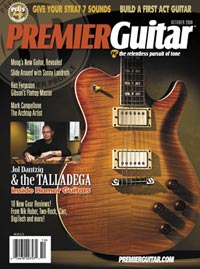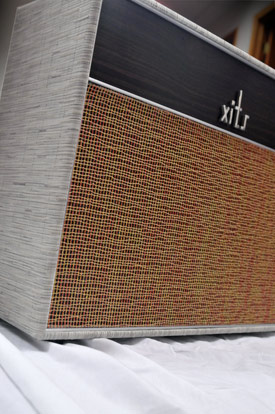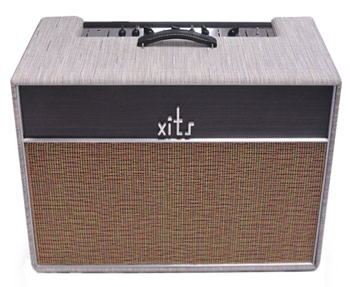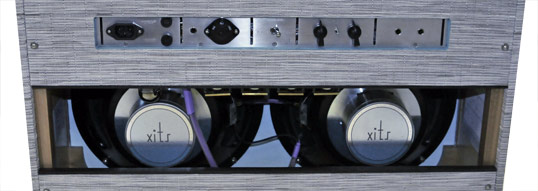
 The first banner on the XITS website reads: “Welcome to total design.” Welcome, indeed. This amp was handmade by Mike Koski in North Liberty, Iowa, and I have to say I think this guy is a genius. To be honest, I’m a diehard when it comes to the classic sixties Vox sound, so just hearing about the XITS got me keyed up. But the way Koski has managed to build an amp that blends together so many seemingly divergent characteristics — refined artistry with raw assertiveness, pure old school tone with state-of-the-art specs, a “come hither” look with a “Stand back, Jack!” sound — into a whole of such singular quality has really kept me keyed up. The word I keep coming back to is astonishing.
The first banner on the XITS website reads: “Welcome to total design.” Welcome, indeed. This amp was handmade by Mike Koski in North Liberty, Iowa, and I have to say I think this guy is a genius. To be honest, I’m a diehard when it comes to the classic sixties Vox sound, so just hearing about the XITS got me keyed up. But the way Koski has managed to build an amp that blends together so many seemingly divergent characteristics — refined artistry with raw assertiveness, pure old school tone with state-of-the-art specs, a “come hither” look with a “Stand back, Jack!” sound — into a whole of such singular quality has really kept me keyed up. The word I keep coming back to is astonishing.
* * *
This 15/30-watt 2×12 combo is the latest in an XITS lineup that started with the Sadie XS (15W 1×12 combo or head) and the Piper XS (15/30W 1×12, 2×12, or head), both featuring a single EF86 Pentode channel. That lineup was expanded to include the twin channel Piper XTB — closest to that legendary AC30 “Top Boost” model — and a 50W model. The Piper X30 features the XITS “Top Boost” channel and a new “Hot Top Boost” channel based on Koski’s own design for the 50W model’s second channel.
Channel 1 of the Piper X30 offers a bright vintage “Top Boost” tone, and features two gain stages and a passive EQ; Channel 2 offers three gain stages and an active EQ for a hotter, rowdier tone, and plenty more grit. Each channels uses a singe high-gain input, and the Cut control is global, rolling off high frequencies in the power section as you turn clockwise.
Captivated as I am by the sound of this amp, I was somewhat surprised to discover the Piper X30 doesn’t fawningly follow the recipe that’s supposed to create that unmistakable AC30 tone. The standard tube complement is there: three 12AX7s in the preamp section, four EL84s (independently cathode biased with no negative feedback) in the power section, and a GZ34 tube rectifier. But from here, the XITS starts to part company with the past. For example, instead of single bias resistor for all four power tubes, Koski uses individual bias resistors for both push-pull pairs; that allows one pair to be removed for 15W operation without changing the bias of the remaining pair.
Another example: although common wisdom says the GZ34 rectifier eliminates the need for a Standby switch, the Piper’s got one. (Koski told me that since it didn’t affect the tone, he added it to keep the tubes warm during breaks. Good idea.) On the back of the amp, a half-power switch deselects one pair of EL84s for 15W output, and our review model also includes the optional XLOOP tube buffered (12AT7) effects loop with individual Send and Return controls, and an additional gain stage on the return. Sweet.
 All of Koski’s XITS amps use custom wound Mercury Magnetics transformers, NOS Allen Bradley carbon comp and PRP resistors, SoZo tone caps, Mallory filter caps, along with Analysis Plus Clear Oval speaker cable. Everything is true point-to-point wired in an aluminum vented chassis, handmade by Koski himself. I got a look under the hood, and it has to be one of the tidiest jobs I’ve seen.
All of Koski’s XITS amps use custom wound Mercury Magnetics transformers, NOS Allen Bradley carbon comp and PRP resistors, SoZo tone caps, Mallory filter caps, along with Analysis Plus Clear Oval speaker cable. Everything is true point-to-point wired in an aluminum vented chassis, handmade by Koski himself. I got a look under the hood, and it has to be one of the tidiest jobs I’ve seen.
There are a few more surprises in store. It seems at once both quieter and louder than a vintage Vox. Although I never expected the amp itself to be silent, it’s actually pretty quiet, until you don’t want it to be, that is. Then it gets loud. Very, very loud. Perhaps that’s got something to do with the loudspeakers. Made for XITS by Austin Speaker Works, the high power X70C ceramic speaker has a 70Hz cone and 80 Watts of power handling. For an additional charge, you can get the optional X70A (Alnico) speakers. They break up beautifully. For me, this put to rest the notion that the original AC30’s underpowered speakers were part of the secret of its tone.
There is more. Take, for instance, the woodwork. Rather than simply replicating a vintage British amp cab, the XITS cabinet incorporates several modifications into those time-tested designs to achieve singular tonal quality, resonance, and visual appeal. The tuned, open-backed cabinet is made from a single plank of maple, box-jointed to keep the grain aligned, and is augmented by walnut bracing and a floating baffle. Let me tell you, it shimmies and shakes like the business on my amp stand.
The entire cabinet interior is finished to furniture-grade, and the exterior is furnished with your choice of Walnut, Zircote, Cocobolo, Mahogany, Ebony, or Cardinal Bloodwood, and topped off with a polished stainless steel faceplate “Xits” logo. Our review model came with a gorgeous ebony valence and matching ebony appointments on both the control panel and the back plate (that’s right, ebony on the back plate). The exterior is covered in Chilewich woven vinyl, which looks sort of delicate but turns out not be, and then equipped with a two layer grill cloth with gold/orange, blue/turquoise, or gold/silver vinyl over black. In keeping with Koski’s unswerving attention to detail, there’s a special grill frame to separate the woven vinyl lattice from the baffle.
The backlit control panel by itself testifies to the Piper’s seamless blend of austerity and imagination. There are two channel inputs, three chicken head knobs per channel, each labeled simply B, T, or V, the global Cut control, or C, and the Power/Standby switch, which is labeled with the Japanese symbol for “fire” (Standby) and a Laurel wreath, the Greek symbol for “skill” (Power On).
“Yes, it looks great in the living room; no, you can’t play it in here.“
 For sure, the Piper X30 is posh. Its elegant design and superb craftsmanship give it a positively urbane charisma, but don’t let the understated look fool you — this amp is no poser. The sound is articulate and full of detail, but it is far from coy. Dime it out and it’ll make the last AC30 you played seem almost tame. So, although it might fit right in with your new Dutch design living room suite, to get the most out of it you’re going to have to crank it up.
For sure, the Piper X30 is posh. Its elegant design and superb craftsmanship give it a positively urbane charisma, but don’t let the understated look fool you — this amp is no poser. The sound is articulate and full of detail, but it is far from coy. Dime it out and it’ll make the last AC30 you played seem almost tame. So, although it might fit right in with your new Dutch design living room suite, to get the most out of it you’re going to have to crank it up.
In fact, what’s so refreshing about this amp, despite its perfectly groomed appearance, is how truly unpretentious it is. It’s got no frills: no master volume, no trem or reverb, no clever tone shapers or brilliance switches. In the tone department, though, it is an unambiguous contender.
When it comes to producing the raw, punchy, volatile sound of the British Invasion, the Piper X30 is a bona fide performer. At lower volumes, Channel 1 delivers pure cleans with warm, smooth mids, round low end, bell-like highs. As you increase the volume it begins to develop a bite, and the chimey ring at the top end becomes fuller and more prominent — the low end loosens up a bit, but the tone remains snappy and distinct throughout, with no trace of the midrange blurriness you sometimes get with amps like this. At top volume and treble, Channel 1 has a beautiful bark and is full of lush sparkle:
![]() Download example 1 — 15W, Ch.1, B at noon, Tat 2 O’c, V at 10 O’c, Cut at noon: recorded in SoundStudio on MacBook Pro using Digidesign Mbox (2 SM57s); Fender Contemporary Telecaster, Neck and Bridge pups, s/c.
Download example 1 — 15W, Ch.1, B at noon, Tat 2 O’c, V at 10 O’c, Cut at noon: recorded in SoundStudio on MacBook Pro using Digidesign Mbox (2 SM57s); Fender Contemporary Telecaster, Neck and Bridge pups, s/c.
As advertised, Channel 2 is more aggressive and grittier. At lower volumes, it has a big, bright attack and a heavy, percussive chime. With more volume, the mids here don’t get much fatter than Channel 1, but they sound fuller, and bottom end gets thick and slightly woolly. At high volume, the top end is a dream: sweet, dense crunch, splendid harmonics, and warm, glassy, singing sustain. The grit cleans up easily with the guitar’s volume knob. The midrange thickens nicely with humbuckers, and the crunch gets a little bit hairy. With the single coil neck pickup on my Tele, the tone gets really greasy and bluesy; with the bridge pickup it goes right to raunchy:
![]() Download example 2 — 15W, Ch.2, B at 1 O’c, T at 3 O’c, V at 11 O’c, Cut at 11 O’c; recorded in SoundStudio on a MacBook Pro using Digidesign Mbox (SM57); Fender Contemporary Tele, Bridge pup, then Neck, S/C.
Download example 2 — 15W, Ch.2, B at 1 O’c, T at 3 O’c, V at 11 O’c, Cut at 11 O’c; recorded in SoundStudio on a MacBook Pro using Digidesign Mbox (SM57); Fender Contemporary Tele, Bridge pup, then Neck, S/C.
When you dial up the treble knob on channel 2, and roll off the cut, the distinctive Voxey sparkle sharpens vividly, delivering a mouthwatering jangle:
![]() Download example 3 — 15W, Ch. 2, Bass at 3 O’c, Treb full, Vol at 11 O’c, no Cut; recorded in Sound Studio on a MacBook Pro using Digidesign Mbox (SM57); Fender Contemp. Tele, Bridge pup, S/C.
Download example 3 — 15W, Ch. 2, Bass at 3 O’c, Treb full, Vol at 11 O’c, no Cut; recorded in Sound Studio on a MacBook Pro using Digidesign Mbox (SM57); Fender Contemp. Tele, Bridge pup, S/C.
The Final Mojo
I was pretty sure the Piper X30 was something else when I got my first good look at it. After playing it and listening to it for a while, I’m convinced that Koski’s meticulous attention to both visual and sonic detail puts this amp in a class all by itself. As a total package — a seamless convergence of technical innovation, craftsmanship, and artistic temperament — this amp is just astonishing.
I’ll admit that I hesitated, at first, to use that word. It sounds so unshakably partisan. But we had the amp out at a Premier Guitar party a few weeks back, and its one-of-a-kind looks piqued the interest of not a few discriminating gear heads. Impressive, sure, but not yet astonishing. When the most frequently heard exclamation coming from the gear heads who did take a closer look at it was, “Oh! you gotta be kidding me.” I sensed we were moving past impressive. But when that inimitable tone could be heard cutting its way through a mix thick with some heavy-hitting amps, including a few 50-watters with 4×12 cabs, astonishing was the only word left.
If you’re on a quest for something that exceeds your every expectation about what a classic handmade, all-tube, AC30-inspired amplifier can be, the XITS Piper X30 is a total design Shangri-La.
Buy if…
you want a handmade amp of unsurpassed quality, exceptional good looks, and astounding tone
Skip if…
you’re looking for an amp with lots of extra features
Rating…
![]()
MSRP $3718 (2×12 Combo base) As Reviewed: $4733 (Alnico Magnet Loudspeakers $200/each, TubeBuffered Effects Loop $615)
XITS Sound
Source: https://mercurymagnetics.com/pages/news/PremierGuitar/PremierG-15.htm